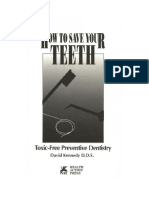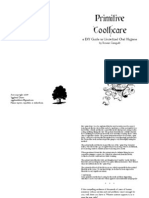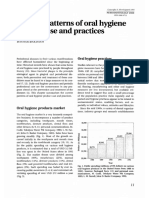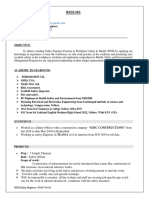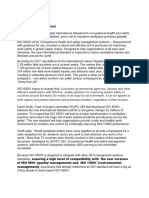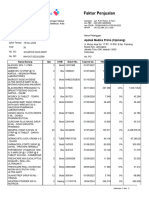Floss PDF
Floss PDF
Uploaded by
kirti vatsaCopyright:
Available Formats
Floss PDF
Floss PDF
Uploaded by
kirti vatsaOriginal Title
Copyright
Available Formats
Share this document
Did you find this document useful?
Is this content inappropriate?
Copyright:
Available Formats
Floss PDF
Floss PDF
Uploaded by
kirti vatsaCopyright:
Available Formats
Home-Care Products
The history and global market of oral
home-care products
Juliana Jobim Jardim(a) Abstract: This literature review reports the history and the current mar-
Luana Severo Alves(b) ket of oral home-care products. It provides information extending from
Marisa Maltz(c)
the products used by our ancestors to those currently available, as well
as on the changes in the supply and consumption of these products. Al-
MSc, Graduate fellow; (b) Graduate fellow;
(a)
though the scientific knowledge about oral diseases has improved greatly
(c)
PhD, Professor – Department of Social and
Preventive Dentistry, School of Dentistry, in recent years, our ancestors had already been concerned with clean-
Federal University of Rio Grande do Sul, ing their teeth. A variety of rudimentary products and devices were used
Porto Alegre, RS, Brazil.
since before recorded history, like chewing sticks, tree twigs, bird feath-
ers, animal bones, tooth powder and home-made mouth rinses. Today,
due to technological improvements of the cosmetic industry and market
competition, home-use oral care products available in the marketplace
offer a great variety of options. An increase in the consumption of oral
care products has been observed in the last decades. Estimates show that
Latin America observed a 12% increase in hygiene and beauty products
sales between 2002 and 2003, whereas the observed global rate was ap-
proximately 2%. A significant increase in the per capita consumption of
toothpaste, toothbrush, mouthrinse and dental floss has been estimated
from 1992 to 2002, respectively at rates of 38.3%, 138.3%, 618.8% and
177.2%. Pertaining to this increased supply and consumption of oral care
products, some related questions remain unanswered, like the occurrence
of changes in disease behavior due to the use of new compounds, their
actual efficacy and correct indications, and the extent of the benefits to
oral health derived from consuming more products.
Descriptors: Oral hygiene; Dental devices, home care; Dentifrices;
Mouthwashes.
Corresponding author:
Marisa Maltz
Faculdade de Odontologia - UFRGS
Departamento de Odontologia Preventiva
e Social
Rua Ramiro Barcelos, 2492
Porto Alegre - RS - Brazil
CEP: 90035-003
E-mail: mmaltz@ufrgs.br
Received for publication on May 04, 2009
Accepted for publication on May 12, 2009
Braz Oral Res 2009;23(Spec Iss 1):17-22 17
The history and global market of oral home-care products
The history of oral home-care toothbrush, an attempt to offer the public a brush
products that could simulate the action of a manual brush,
Bacterial biofilm is a natural component of the was developed in 1939 in Scotland, but did not ap-
oral environment and is compatible with health in pear on the market until the 1960s.
balance situations. When biofilm accumulation on Ancient Greek and Roman literature had first re-
dental or gingival tissues occurs for a certain period ported the use of twigs as primitive toothpicks to
of time and combined with others factors, it can lead remove food and debris from between the teeth. The
to dental caries or periodontal disease – the major intent of early humans was probably not to clean the
causes of tooth loss everywhere in the world1 and teeth but simply to remove an unpleasant subjective
the two most common chronic human diseases. 2 sensation. The Greeks tended to keep these little in-
Although the scientific knowledge about the struments in their mouths continuously and were
etiology and dynamics of the development of oral often referred to as “toothpick chewers”. 2 Around
diseases has presented a great improvement in the 1600 BC, the Chinese also used twigs made of trees
last decades, man has tried to find ways to clean his carefully chosen from aromatic species that had the
teeth since a remote past. ability to clean and freshen the mouth. Wealthy citi-
A variety of oral hygiene measures has been used zens often carried their gold or silver toothpicks in
since before recorded history. This has been verified fancy cases and used them ostentatiously at meals.
by excavations done all over the world, in which Many religions, both before and after the Christian
chewing sticks, tree twigs, bird feathers and animal era, enjoined their adherents to practice cleanliness
bones were found. of the teeth using twig cuts as a tooth-pick. 3
The early history and evolution of the tooth- The development of toothpaste began as long ago
brush has its origin in the chewing sticks used by as 300-500 BC in China and India. First attempts
the Babylonians as early as 3500 BC. Also known at tooth cleaning included using abrasives such as
as “miswak” or “siwak”, it was also an ancient crushed bone, crushed egg and oyster shells.4 Tooth
pre-Islamic habit. Mohammed was an enthusiastic powder was the first noticeable advance, and was
supporter of its use as a “purgative for the mouth”. made up of elements like powdered charcoal, pow-
He used to report that “it makes the teeth white, dered bark, salt and some flavoring agents. 5
clarifies the understanding, makes the breath fra- Modern toothpastes were developed in the
grant, dries up the phlegm, strengthens the gums 1800s. As the years passed, new components were
around the teeth, makes the glance clear, sharpens added to their formulations, as soap and chalk. In
the power of the vision, opens the bowels and whets 1873, toothpaste was firstly mass-produced. Due to
the appetite”, evidencing that, for some, “miswak” advancements in synthetic detergents after World
was not only a personal hygiene habit but also a War II, the soap was replaced for emulsifying agents
spiritual custom. The chewing stick was a rudimen- such as sodium lauryl sulphate and sodium ricinole-
tary toothbrush used as a single agent or with tooth ate. Fluoride was added initially in 1914, but the
powder or extract of roses. 2 American Dental Association at first criticized its
The first true bristled toothbrush was originat- introduction. The ADA finally consented to the use
ed in China at around 1600 AD. The first modern of fluoride in toothpastes in 1960.
toothbrush was reinvented in the late 18th and early Besides the traditional tooth paste and brush, a
19th centuries. 2 The first patent for a toothbrush was great variety of home-use oral products have been
credited to H. N. Wadsworth in 1857, in the United developed.
States, but due to the high price of the hog bristle, A concern about the cleaning of approximal
the mass production of the product in America only surfaces was first reported by Levi Parmly (1790-
started in the end of the 19th century. As technol- 1859), the inventor of dental floss.6 He stated that
ogy progressed, natural swine bristles were replaced the device should “be passed through the interstices
by synthetic fibers, usually nylon. The first electric of the teeth, between their necks and the arches of
18 Braz Oral Res 2009;23(Spec Iss 1):17-22
Jardim JJ, Alves LS, Maltz M
the gum, to dislodge that irritating matter which no consumption of oral health products and their main
brush can remove and which is the real source of dis- reasons are discussed.
tress”. Dental floss made of silk was used since the
19th century, while nylon floss was made available in The market of oral home-care
the marketplace right after World War II. The diffi- products
culty of flossing explains its reduced use and makes Nielsen Company7 (2004) studied the sales of
this technique less than universal. 2 Other interden- hygiene and beauty products in 56 countries com-
tal cleaning devices have been developed, such as prising 95% of the world Gross Domestic Product
rubber tip stimulators and interdental brushes. (GDP) and 75% of the world population. They di-
The first known reference to mouth rinsing is vided the Hygiene and Beauty products in 9 catego-
found in Chinese medicine, around 2700 BC. Later ries: baby products, cosmetics, hair products, paper
on, in the Greek and Roman periods, mouth rinsing products, oral hygiene, body hygiene and moistur-
following mechanical cleansing became common izing, facial hygiene and moisturizing, sunscreen
among the upper classes, and Hippocrates recom- and hair removal. Although hygiene and beauty
mended a mixture of salt, alum and vinegar2 while products are among the categories with the lowest
Pythagoras recognized the freshening effect of an- sales increase in the world, around 2%, they rank
ise.5 Different products were used for mouth rins- fourth in sales (Graph 1). And Latin America has
ing over the centuries. In the 1500s, wine or beer shown larger growth rates than those of the rest of
were used; in the late 19th century, around 1890, the world. The oral hygiene products market pre-
the use of essential oils was introduced among the sented an increase of 12% between 2002 and 2003,
dental care habits. 2 Freshening bad breath has been as shown in Graph 2.
the traditional use of mouth rinsing. Besides this The consulting firm Kline & Company8 (2004)
cosmetic purpose, therapeutic mouth rinsing is now studied the sales of oral care products in 16 coun-
available, including fluoride, quaternary ammonium tries. According to this study, Brazil occupied in
compounds and chlorhexidine. 2004 the 10th position in sales of oral care products.
Today, due to technological improvements of the The sales in Brazil were ahead of countries with
cosmetic industry and market competition, home- higher economic power, like Canada and Spain, and
use oral care products available in the marketplace countries in Latin America like Argentina (Table 1).
offer the consumer a wide variety of options. The The consumption of toothpaste and toothbrush
toothbrush head is presented in different forms and per inhabitant per year is respectively 90% and
sizes; bristles are presented in different hardness 110% higher in Brazil compared with Argentina,9
options (hard, medium, soft or extra-soft). Tooth- as shown in Table 2. In 2004, the sales of oral
pastes are presented in different concentrations of health products in Brazil was five times the sales of
fluoride (from formulations without this component these products in Argentina, even though Argenti-
to versions with a very high concentration of it, such na showed a sales increase 8 times higher than that
as 5000 ppm); and special versions present natural of Brazil from 2003 to 2004. The consumption of
components, such as propolis and jua, for specific toothpaste, toothbrush, mouthrinse and dental floss
purposes, as tooth bleaching, dental erosion control had increased significantly, as can be seen in Table 3
or to reduce sensitivity. Mouth rinses have a cosmet- (absolute values) and Table 4 (average per capita).
ic or therapeutic use, just for mouth freshening or Comparing the consumption per capita of these
for controlling plaque, gingivitis and dental caries. products, an increase of 38.3% in toothpaste,
Owing to the wide variety of products available 138.3% in toothbrush and 177.2% in dental floss
in the marketplace and the strong appeal to consum- can be noticed from 1992 to 2002.9 Of all the oral
ers exerted by the cosmetic industry, the consump- care products, mouthrinse is the one that presented
tion of oral care products has increased in the last during this period the most outstanding increase in
decades. In the following section, the changes in the sales: 618.5%. This could be due to the fact that the
Braz Oral Res 2009;23(Spec Iss 1):17-22 19
The history and global market of oral home-care products
Hair removal +4%
Graph 1 - World sales of Hygiene
2002
and Beauty products. Growth by
2003
Sunscreen +5% basket of products (number of
countries covering the categories in
Facial hygiene/moisturizing +7%
each basket of products).7
Body hygiene/moisturizing +5%
Oral hygiene +2%
Paper products +1%
Hair products +4%
Cosmetics 0%
Baby products 0%
(US$ Millions) 0 500 1,000 1,500 2,000 2,500 3,000
Graph 2 - Sales of Hygiene and
Hair removal +9% 2002
Beauty products in Latin America.
2003
Sunscreen +22% Growth by basket of products
(number of countries covering
Facial hygiene/moisturizing +7%
the categories in each basket of
Body hygiene/moisturizing +13% products).7
Oral hygiene +12%
Paper products +7%
Hair products +12%
Cosmetics -14%
Baby products +7%
(US$ Millions) 0 500 1,000 1,500 2,000 2,500 3,000
supply of these products was significantly enhanced centimeters per day). Comparing these recent data
in the past 10 to 15 years. New mouthrinses for with those showed previously, we can observe that
biofilm control and caries prevention, using differ- the consumption of toothbrush increased from 1.12
ent active compounds, such as essentials oils, nat- in 2002 to 1.67 in 2009.
ural products (propolis and jua), cetylpyridinium Current data from ABIHPEC10 (2008) shows
chloride and fluoride are available at lower prices, that the market of oral care products has increased
and are produced by a larger variety of companies. from 2002 to 2006 in Brazil, when it was handling
The newest product release on the marketplace is a around US$ 746.1 × 103, as shown in Graph 3. As
mouthrinse for dental bleaching. There is no data to the sales share in 2006, toothpaste represented
concerning the increase in over-the-counter dental 66%, dental floss, 21%, mouthrinse, 9% and tooth-
bleaching products in Brazil; however, global data brush, 4% (Graph 4).10
from Nielsen7 (2004) showed a 48% sales increase In general, four reasons for this sales increase
from 2002 to 2003. of oral care products in Brazil were pointed out by
According to internal estimates from Colgate- ABIHPEC10 (2004) and confirmed by Nielsen7. The
Palmolive (unpublished data), toothpaste is in 99.9% reasons are:
of Brazilian homes. Each Brazilian consumes, per 1. Women’s increasing participation in the labor
year, 1.67 toothbrush, 126 milliliters of mouthrinse market: this fact created a need for practical
and 18.8 meters of dental floss (which means 5.1 products, in addition to an increase in the pur-
20 Braz Oral Res 2009;23(Spec Iss 1):17-22
Jardim JJ, Alves LS, Maltz M
chasing power of the household. Hence, prod- 2. The use of cutting-edge technology by the indus-
ucts that presented a faster and easier way of use, try, leading to increased productivity and, conse-
like disposable dippers, had their sales increased. quently, lower prices to consumers.
Dental home bleaching products, for example, 3. Constant release of different products, in an at-
are also time- and moneysaving alternatives to a tempt to meet the consumers’ needs for new and
dental visit. interesting formats. An example is the addition
of the strip format to the mouth-refreshing cat-
egory. Innovations in oral care products are con-
Table 1 - Oral care products sales in 2004.8
stantly being released onto the marketplace, like
Ranking Country Sales (US$ millions) combinations of dentifrice, mouthrinse, dental
1 USA 2,738 bleaching and desensitizer in a single product.
2 China 1,335 4. An increase in life expectancy, which leads to an
3 Germany 1,021 increase in the proportion of elder consumers.
4 Japan 959 This share of the population is growing faster
5 Russia 863 in Latin America than in the rest of the world.
The increasing desire to preserve a youthful ap-
6 United Kingdom 639
7 India 617
8 Italy 600 Table 2 - Average consumption of toothpaste (kg/inhabit-
ant) and toothbrush (unit/inhabitant), per year, in selected
9 France 592
countries in 2002.9
10 Brazil 506
Consumption of
11 Mexico 393 Consumption of toothpaste
Country toothbrush (unit/
(kg/inhabitant)
12 South Korea 360 inhabitant)
13 Canada 234 Argentina 0.21 0.41
14 Spain 207 Canada 0.26 0.88
15 Poland 185 Mexico 0.30 0.69
16 Argentina 75 Brazil 0.40 0.86
Table 3 - Consumption of toothpaste (ton), toothbrush Table 4 - Average consumption of toothpaste (gram), tooth-
(unit), mouthrinse (ton) and dental floss (unit) in Brazil be- brush (unit), mouthrinse (gram) and dental floss (unit) per
tween 1992 and 2002.9 capita in Brazil between 1992 and 2002.9
Product Product
Year Year
Toothpaste Toothbrush Mouthrinse Dental Floss Toothpaste Toothbrush Mouthrinse Dental Floss
1992 63,200 71,688 825 15,350 1992 415.2 0.47 5.4 0.101
1993 62,980 82,693 843 16,032 1993 407.6 0.54 5.5 0.104
1994 69,820 101,065 1,309 17,783 1994 445.4 0.64 8.4 0.113
1995 67,394 111,758 2,131 22,635 1995 423.8 0.70 13.4 0.142
1996 77,455 113,481 2,890 22,995 1996 480.3 0.70 17.9 0.143
1997 84,629 122,601 3,569 22,921 1997 517.7 0.75 21.8 0.140
1998 90,163 137,064 4,258 25,881 1998 544.2 0.83 25.7 0.156
1999 96,151 139,546 3,577 30,319 1999 572.6 0.83 21.3 0.180
2000 95,466 151,921 3,448 31,250 2000 560.9 0.89 20.3 0.184
2001 104,075 184,768 5,438 45,000 2001 603.7 1.07 31.5 0.261
2002 100,308 196,264 6,773 48,954 2002 574.4 1.12 38.8 0.280
Braz Oral Res 2009;23(Spec Iss 1):17-22 21
The history and global market of oral home-care products
9% 4%
800 746.1
Toothpaste
617.6
Dental floss
600 21%
US$ · 103
453.1 Mouthrinse
406.9
351.2 349.0 Toothbrush
400
200
0
2001 2002 2003 2004 2005 2006
66%
Year
Graph 3 - Sales of oral care products from 2001 to 2006 Graph 4 - Oral care products sales share in 2006 in Brazil
in Brazil. Values are expressed in dollars.10 (Source: ABIHPEC).10
pearance is reflected by an enhancement in the America,7 for example. Some questions arise from
development of anti-aging products. The sales observing the current data. Has the behavior of
increase of dental bleaching agents is also a re- dental diseases changed over the time due to expo-
flection of this situation. sure to compounds like fluoride, antimicrobials or
Since remote times, our ancestors were con- chlorhexidine? Do dental professionals know the
cerned with cleaning their teeth and keeping their actual efficacy and the correct indications of the
mouths fresh and healthy. They developed a variety available products? To what extent the increased
of rudimentary devices and products, which ulti- supply and consumption of home-care products has
mately led to today’s availability of a wide range of actually promoted an improvement in oral health?
oral home-care products. A large increase has been Future investigations may answer these questions in
observed in the consumption of these products in order to guide consumers and professionals in using
a short time interval: 12% over one year in Latin oral home-care products.
References
1. Baelum V, Luan WM, Chen X, Fejerskov O. Predictors of [online]. São Paulo: Nielsen Global Services; 2004. Available
tooth loss over 10 years in adult and elderly Chinese. Com- from: http://www.acnielsen.com.br.
munity Dent Oral Epidemiol. 1997;25:204-10. 8. Kline & Company. Global Cosmetics & Toiletries 2004:
2. Fischman S. The history of oral hygiene products: how far have World Overview [online]. Kline & Company: Business process
we come in 6000 years? Periodontol 2000. 1999;15:7-14. management consulting and industry market research reports.
3. Campbell JM. Dentistry then and now. 2nd ed. Edinburgh: Available from: http://www.klinegroup.com/.
Privately Printed for the author; 1963. 9. Manfredini MA. Características da indústria de equipamentos
4. Ring ME. História ilustrada da Odontologia. São Paulo: Ma- odontológicos e de produtos para higiene bucal no Brasil entre
nole; 1998. 1990 e 2002 [Dissertação de Mestrado]. São Paulo: Coordena-
5. Lerman S. Historia de la Odontologia y su ejercicio legal. 2nd ed. doria de Controle de Doenças da Secretaria de Estado da Saúde
Buenos Aires: Mundi; 1964. de São Paulo; 2006.
6. Sanoudos M, Christen AG. Levi Spear Parmly: The Apostle 10. Abihpec. São Paulo: Associação Brasileira da Indústria de Hi-
of Dental Hygiene. J Hist Dent. 1999;47(1):3-6. giene Pessoal, Perfumaria e Cosméticos; 2008. Available from:
7. Nielsen Company. Os produtos mais quentes do mundo - infor- www.abihpec.org.br.
mações sobre o crescimento de categorias de higiene & beleza
22 Braz Oral Res 2009;23(Spec Iss 1):17-22
You might also like
- How To Save Your TeethDocument193 pagesHow To Save Your TeethTanon Jaturonnatee100% (2)
- Gulf Importer List Dubai UAEDocument5 pagesGulf Importer List Dubai UAEKharisma Rizky Nugraha100% (4)
- Stress and Fatigue in AviationDocument72 pagesStress and Fatigue in AviationAbd Zouhier0% (1)
- The Evolution of A Tooth Brush From Antiquity To Present - A Mini ReviewDocument4 pagesThe Evolution of A Tooth Brush From Antiquity To Present - A Mini ReviewRafi Kusuma Ramdhan SukonoNo ratings yet
- An Introduction To Toothpaste - Its Purpose, History and IngredientsDocument14 pagesAn Introduction To Toothpaste - Its Purpose, History and IngredientsInge Yuni LestaryNo ratings yet
- A Review On ToothpasteDocument31 pagesA Review On ToothpastekhushalsharmadausaNo ratings yet
- A Review On Toothbrushes and Tooth Brushing MethodsDocument10 pagesA Review On Toothbrushes and Tooth Brushing MethodsinventionjournalsNo ratings yet
- G06052938 PDFDocument10 pagesG06052938 PDFSiti Fatimah Khaerun NisaNo ratings yet
- Dental HygieneDocument8 pagesDental HygieneNurul HanifahNo ratings yet
- Abubakar Osman - Final PaperDocument14 pagesAbubakar Osman - Final Paperapi-599672379No ratings yet
- Composition of Ion in ToothpasteDocument30 pagesComposition of Ion in Toothpastedibashkumar7896No ratings yet
- Primitive ToothcareDocument8 pagesPrimitive Toothcaresui pachaNo ratings yet
- Oral Hygiene ProductsDocument5 pagesOral Hygiene ProductsMuhammad ZeeshanNo ratings yet
- 9thpublication IJPSI 5thnameDocument11 pages9thpublication IJPSI 5thnameElisabeth FransiskaNo ratings yet
- Imfeld Chewing GumDocument15 pagesImfeld Chewing GumEchaaNo ratings yet
- Current Patterns of Oral HygieneDocument4 pagesCurrent Patterns of Oral Hygienecruzjulio480No ratings yet
- Herbal Mouthwash Past, Present and FutureDocument10 pagesHerbal Mouthwash Past, Present and FutureInternational Journal of Innovative Science and Research TechnologyNo ratings yet
- Project Final ThesisDocument38 pagesProject Final Thesisjasminepatnaik2018No ratings yet
- Dental Hygiene and Periodontal DiseaseDocument7 pagesDental Hygiene and Periodontal Diseaseapi-536835901No ratings yet
- Vikas Bairwa 500 RuDocument33 pagesVikas Bairwa 500 RukhushalsharmadausaNo ratings yet
- Prevention of Periodontal DiseasesDocument53 pagesPrevention of Periodontal DiseasesmisdduaaNo ratings yet
- Bacterial Contamination of The ToothbrushesDocument7 pagesBacterial Contamination of The ToothbrushesFilip KoneskiNo ratings yet
- Boniek 2011Document8 pagesBoniek 2011Juan Carlos SaavedraNo ratings yet
- Introduction of ToothpasteDocument64 pagesIntroduction of ToothpastePrashant SinghNo ratings yet
- Dental Caries StrategiesDocument23 pagesDental Caries StrategiesCarlos Alberto CastañedaNo ratings yet
- History of Toothbrushes and ToothpastesDocument15 pagesHistory of Toothbrushes and ToothpastesShams SNo ratings yet
- Evolution of Standardised QuipmentDocument2 pagesEvolution of Standardised QuipmenteashwarsiddhaNo ratings yet
- Oral Health Design ProjectDocument21 pagesOral Health Design Projectapi-272723910No ratings yet
- 1 s2.0 S0002817717304129 MainDocument10 pages1 s2.0 S0002817717304129 Mainianacgoncalves1No ratings yet
- 76 82 PBDocument37 pages76 82 PBDang Pham HaiNo ratings yet
- Dentifrice Fricare Your TeethDocument4 pagesDentifrice Fricare Your Teethprabhanshusrivastava2No ratings yet
- Prehistoric Times Horse Hair Was Used As FlossDocument1 pagePrehistoric Times Horse Hair Was Used As FlossNeviesNo ratings yet
- Launching of A Toothpaste Brand in Algeria UsingDocument10 pagesLaunching of A Toothpaste Brand in Algeria UsingNumair MalikNo ratings yet
- Bleaching: Bleaching and Its Relevance To Esthetic DentistryDocument64 pagesBleaching: Bleaching and Its Relevance To Esthetic DentistryValentina BadiuNo ratings yet
- Prevention of Oral Diseases For The Older Person (Part 2) : ClinicalDocument5 pagesPrevention of Oral Diseases For The Older Person (Part 2) : ClinicalFatima AliNo ratings yet
- Accelerating The Phase Down of Dental Amalgam in Africa and Developing Economies A Leapfrogging StrategyDocument7 pagesAccelerating The Phase Down of Dental Amalgam in Africa and Developing Economies A Leapfrogging StrategyScivision PublishersNo ratings yet
- Dentifrices: An Overview From Past To Present: Dr. Songa Vajra Madhuri and Dr. Lahari BuggapatiDocument4 pagesDentifrices: An Overview From Past To Present: Dr. Songa Vajra Madhuri and Dr. Lahari Buggapatiprabhanshusrivastava2No ratings yet
- The Importance of Toothbrushing and Oral Hygiene IDocument11 pagesThe Importance of Toothbrushing and Oral Hygiene IbambichanlovescumNo ratings yet
- PREFACEDocument15 pagesPREFACEWaseem AnsariNo ratings yet
- PODWIZ Dentistry HistoryDocument4 pagesPODWIZ Dentistry HistoryEduarda DrakeNo ratings yet
- Nanomaterials 10 00140 v3Document32 pagesNanomaterials 10 00140 v3KOMISI I DPM FKG UBNo ratings yet
- Indian Oral Care Industry - Industry ReportDocument8 pagesIndian Oral Care Industry - Industry ReportGnanashre100% (1)
- Dentifrices - An Update: Robin Davies, Crispian Scully, Antony J. PrestonDocument7 pagesDentifrices - An Update: Robin Davies, Crispian Scully, Antony J. Preston2oclockNo ratings yet
- 1 s2.0 S000281771730822X MainDocument3 pages1 s2.0 S000281771730822X MainHoàng Gia Bảo NguyễnNo ratings yet
- Overview On Concepts of Dental Caries Hemabs, Saloni Goenka, Poorva VermaDocument9 pagesOverview On Concepts of Dental Caries Hemabs, Saloni Goenka, Poorva VermaAmee PatelNo ratings yet
- Curs MD Si TD II Sem 2 Dentistry 4Document37 pagesCurs MD Si TD II Sem 2 Dentistry 4P?TR�NJEI BOGDAN- ALEXANDRUNo ratings yet
- Dentifrice PDFDocument16 pagesDentifrice PDFdivyarati100% (1)
- History of Dentistry: Other Fun Teeth FactsDocument9 pagesHistory of Dentistry: Other Fun Teeth FactsleviNo ratings yet
- Chapter 1 Introduction To Dental MaterialsDocument12 pagesChapter 1 Introduction To Dental MaterialsMaria Mercedes LeivaNo ratings yet
- Toothbruch CrisisDocument10 pagesToothbruch Crisiszep0No ratings yet
- Alarming Findings On Mercury Dental Amalgam Latest Research Using The National Health and Nutrition Examination Survey Nhanes DatDocument6 pagesAlarming Findings On Mercury Dental Amalgam Latest Research Using The National Health and Nutrition Examination Survey Nhanes DatScivision PublishersNo ratings yet
- Dental PBLDocument9 pagesDental PBLJoee LimNo ratings yet
- Toothpaste: MEEN 3512 - Industrial Processes Renefer R. Tolentino Jr. Engr. Arian Jhon C. CruzatDocument6 pagesToothpaste: MEEN 3512 - Industrial Processes Renefer R. Tolentino Jr. Engr. Arian Jhon C. CruzatJustine SerranoNo ratings yet
- The Biology, Prevention, Diagnosis and Treatment of Dental CariesDocument10 pagesThe Biology, Prevention, Diagnosis and Treatment of Dental CariesVanlalnghaki KhiangteNo ratings yet
- CariesDocument5 pagesCariesShinta AlfianiNo ratings yet
- 12.dental Caries - 3rd YrsDocument128 pages12.dental Caries - 3rd Yrsw7909137No ratings yet
- Documento de GlosasDocument2 pagesDocumento de GlosasannmarievegapaganNo ratings yet
- Assessment of User Satisfaction of Bamboo Toothbrushes Among Students of Dental Institute of North Gujarat A Questionnaire StudyDocument4 pagesAssessment of User Satisfaction of Bamboo Toothbrushes Among Students of Dental Institute of North Gujarat A Questionnaire StudyInternational Journal of Innovative Science and Research TechnologyNo ratings yet
- The Long Climb: From Barber-Surgeons to Doctors of Dental SurgeryFrom EverandThe Long Climb: From Barber-Surgeons to Doctors of Dental SurgeryNo ratings yet
- Hyderabad NotesDocument2 pagesHyderabad NotesNirajan SharmaNo ratings yet
- Contractor InductionDocument2 pagesContractor InductionTASHNo ratings yet
- STRATEGIC-MANAGEMENT-PAPER - Lung Center PhilippinesDocument48 pagesSTRATEGIC-MANAGEMENT-PAPER - Lung Center PhilippinesDave VillasantaNo ratings yet
- Wellness Research PaperDocument26 pagesWellness Research PaperjohangreeneNo ratings yet
- Business Management System - Integrated 9 & 14 & 45Document36 pagesBusiness Management System - Integrated 9 & 14 & 45tumelo makgabutlaneNo ratings yet
- TraducereDocument10 pagesTraducereAnamaria AvramNo ratings yet
- Chap 9 The Health Care Delivery SystemDocument26 pagesChap 9 The Health Care Delivery Systemjocelyn bernardoNo ratings yet
- Movie ReviewDocument2 pagesMovie Reviewgabriellevelasco23No ratings yet
- Intestinal Coccidian ParasitesDocument23 pagesIntestinal Coccidian ParasitesABC100% (1)
- Embrace SP Version Bi TC 201612 FinalDocument9 pagesEmbrace SP Version Bi TC 201612 Finalka yat ngaiNo ratings yet
- Systematic Literature Review SvenskaDocument6 pagesSystematic Literature Review Svenskafihum1hadej2100% (1)
- Vacuum Therapy Pros and ConsDocument4 pagesVacuum Therapy Pros and ConsSylvia M “Queen Bee” BNo ratings yet
- ERMP 2024 Implementation Guide LineDocument23 pagesERMP 2024 Implementation Guide LineMariamawit TsehayNo ratings yet
- Resume: Email Id: Profession: HSE Safety Engineer. Mobile No: Nellore, A.P IndiaDocument3 pagesResume: Email Id: Profession: HSE Safety Engineer. Mobile No: Nellore, A.P IndiaVivek VjNo ratings yet
- - periodontal Ligament Ppt - نسخةDocument43 pages- periodontal Ligament Ppt - نسخةkoka51339No ratings yet
- Iso+news+item Iso+45001 FinalDocument2 pagesIso+news+item Iso+45001 Finalyuuuto7070No ratings yet
- Faktur Penjualan Offline Medisend Ptmedikabinainv 231024142446Document3 pagesFaktur Penjualan Offline Medisend Ptmedikabinainv 231024142446firaNo ratings yet
- Bitabian National High SchoolDocument4 pagesBitabian National High SchoolJoseph S. Palileo Jr.No ratings yet
- Mil Take Away Record 2Document1 pageMil Take Away Record 2wutNo ratings yet
- Community Health NursingDocument11 pagesCommunity Health Nursingmscfiles2703No ratings yet
- Vital Technical Sdn. BHD.: VT-210 High Performance SealantDocument4 pagesVital Technical Sdn. BHD.: VT-210 High Performance Sealantkhai ruleNo ratings yet
- NHS UK Distension, Manipulation Under Anaesthetic and Arthroscopic Capsular ReleaseDocument3 pagesNHS UK Distension, Manipulation Under Anaesthetic and Arthroscopic Capsular ReleasemertNo ratings yet
- Offer Letter - 1Document2 pagesOffer Letter - 1doc.plloan1No ratings yet
- Conscientiousn Ess: Industriousness & Orderliness: Lecture Notes 7Document7 pagesConscientiousn Ess: Industriousness & Orderliness: Lecture Notes 7Danilo PesicNo ratings yet
- Infinity Manual GuideDocument360 pagesInfinity Manual GuideMarian ErumNo ratings yet
- Community Action: Preventive Intervention at The Community LevelDocument8 pagesCommunity Action: Preventive Intervention at The Community LevelBilly JoeNo ratings yet
- ISO 17025 Risk Management Example: December 2019Document6 pagesISO 17025 Risk Management Example: December 2019paeg6512100% (1)
- Week2 RLE FNCP BSN2Y1-3ADocument8 pagesWeek2 RLE FNCP BSN2Y1-3ANiphey DananNo ratings yet
